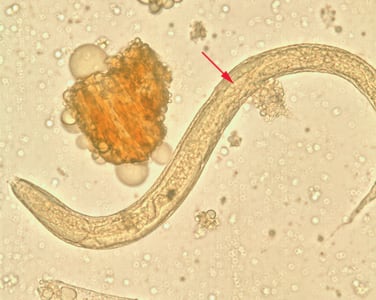Like hookworms, Strongyloides larvae enter the body through exposed skin, such as bare feet. It is often associated with agricultural activities. People infected with HTLV-1 are more likely to become infected with Strongyloides and are prone to develop severe cases of strongyloidiasis. Interestingly, HIV/AIDS infection has not been shown to be a risk factor for acquiring strongyloidiasis or having a worse clinical course.
Pathogenesis: Strongyloides stercoralis is the most commonly implicated species. The filariform larvae penetrate the human host skin and migrate to the small intestine. The larvae migrate via the bloodstream and lymphatics to the lungs, where they are eventually coughed up and swallowed. In the small intestine, the larvae molt twice and become adult female worms. The females live embedded in the submucosa of the small intestine and produce eggs via parthenogenesis (parasitic males do not exist), which yields rhabditiform larvae. The rhabditiform larvae can either be passed in the stool or can cause autoinfection. Rhabditiform larvae in the gut become infective filariform larvae that can penetrate either the intestinal mucosa or the skin of the perianal area, resulting in autoinfection. And they eventually enter the bloodstream and the cycle follows. The significance of autoinfection in Strongyloides is that untreated cases can result in persistent infection leading to hyperinfection syndrome. Transmission of S.fuelleborni subsp. kellyi to infants as a result of breastfeeding has been reported.

Clinical features: It presents with localized pruritic, erythematous rash at the site of skin penetration. Patients may then develop tracheal irritation and a dry cough as the larvae migrate from the lungs up through the trachea. After the larvae are swallowed into the gastrointestinal tract, patients may experience diarrhea, constipation, abdominal pain, and anorexia. Chronic strongyloidiasis is generally asymptomatic, but a variety of gastrointestinal and cutaneous manifestations may occur. Rarely, patients with chronic strongyloidiasis may develop other complications (e.g. arthritis, cardiac arrhythmias, chronic malabsorption, duodenal obstruction, nephrotic syndrome, recurrent asthma). Up to 75% of people with chronic strongyloidiasis have mild peripheral eosinophilia or elevated IgE levels.
Hyperinfection syndrome is often seen in patients receiving high dose corticosteroid therapy. An unusually large number of parasites are seen in hyperinfection syndrome. The larvae are limited to the GI tract and the lungs in hyperinfection syndrome while in disseminated strongyloidiasis numerous other organs are also affected.
“Larva currens” presents as recurrent, serpiginous, maculopapular rashes on buttocks, perineum and thighs. It is due to subcutaneous migration of filariform larvae in autoinfection.
“Swollen belly syndrome” is seen in infants with S. fuelleborni subsp. Kellyi infections. It is a fatal, systemic illness involving protein-losing enteropathy and ascites.
Laboratory diagnosis of Strongyloidiasis: S.stercoralis infections are best diagnosed by serology as the larvae are infrequently passed in stool. Indirect immunofluorescence, CFT, RIA for IgE, gelatin particle agglutination test, Western blot and ELISA can be used for diagnosis. S.stercoralis larvae can be demonstrated in stool samples. Children with S. fuelleborni infection shed eggs rather than larvae in the feces, and the infection is easily diagnosed using microscopic techniques.